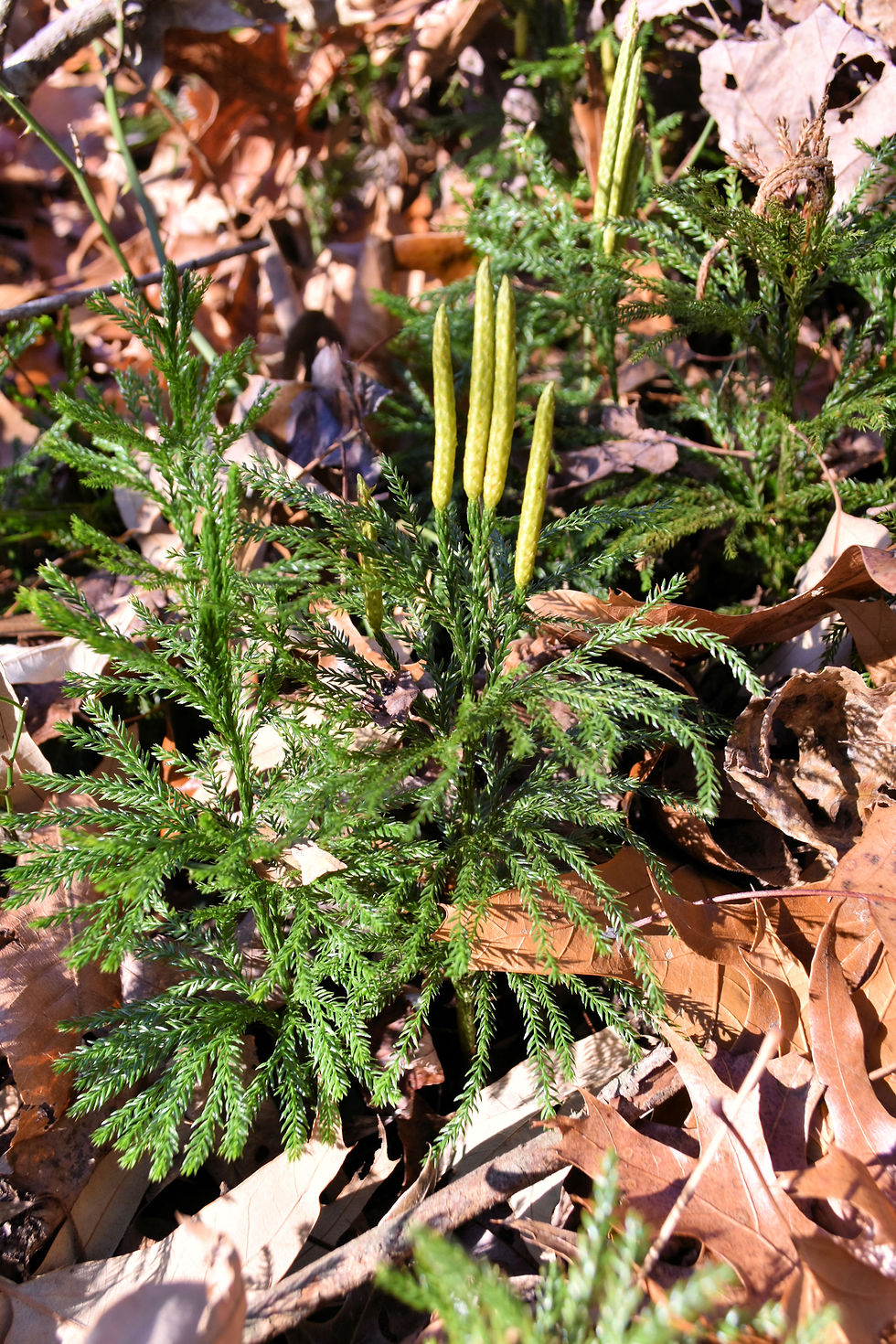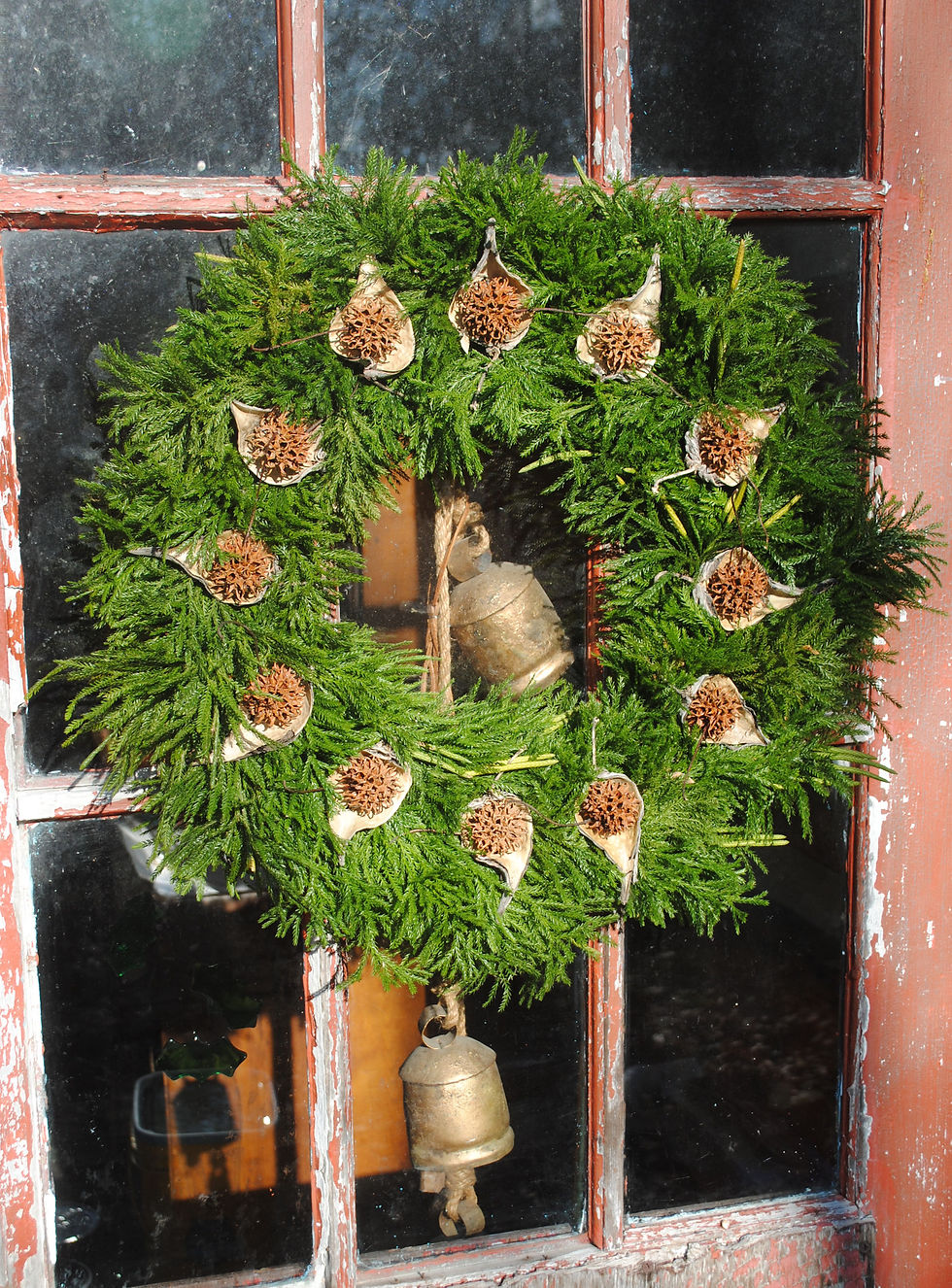Lycopodiums (or Clubmoss)
- Paul Layton

- Dec 17, 2021
- 5 min read
Updated: Dec 18, 2021

Finally! Here was the small ad in the classified section of the Milford Chronicle that I had been waiting for: “Wanted, Turkeybeard. 5 cents a pound. Contact Ed Passwaters, Union Church Rd, Greenwood”. This would be my ticket to Christmas spending money since I knew where lots of turkeybeard and running pine grew.

These were the names that locals used for the two most common species. At that time during the 1950’s, for 25 cents I could buy two comic books and a Coke at the news- stand on Walnut St., Milford, between Lou’s Bootery and the Benjamin Franklin 5 & 10.

This was perfect for me because all a boy needed was a burlap sack and his wits to make a buck. The next evening after the school bus dropped me off at 3:45, I quickly changed into old clothes, grabbed a sack from the barn, and headed to the pine woods behind Dad’s “Knight” sawmill. (Trivia: This sawmill was powered by a Cadillac LaSalle engine that my dad had installed.) At this point in my life, I knew where every “green” thing grew for a mile in any direction. Neighboring farmers allowed neighbor’s kids to wander freely from farm to farm. Everybody knew everybody. Between my grandmother, my father, Mr. Sharp and Mrs. Bacon, neighbors on either side, I probably had 300 acres to explore.

We always pulled turkey beard carefully, more or less just thinning the colony to ensure there would be plenty for the next year. The large colony that is presently on our farm has provided Christmas greenery for five generations over the last 100+ years and is actually increasing in area.


There are three species of Lycopodiums (Clubmosses) in our immediate area. At that age I only knew of two. The dark green upright Tree Clubmoss (Lycopodium obscurum) which made the finest wreaths but is difficult to pull, and the Running Pine (Lycopodium flabelliforme) that grew in abundance in our pine woods. Since the running pine plants were connected by a shallow runner just below the organic leaf duff, it was much easier to harvest. When you pulled up one plant, a string of as many as a dozen plants would come along too. Our family used both types as Christmas greenery. Running pine was what I concentrated on for my business venture.
After school on my hands and knees in the wet pine needles, working until dark in the short evenings of December, I pulled one third of a sack the first evening. This was stored in the corncrib to keep it cool and out of the rain. For the next week whenever weather, homework, or other chores permitted, I pulled Christmas greens. From time to time I weighed the sacks to see how things were progressing. As I remember, I was amazed at the volume of running pine it took to make a pound.

Daddy had agreed to deliver the harvest to Ed, since he was an acquaintance. (Dad knew everyone, it seemed). On a Wednesday evening, Dad loaded the sacks in the trunk of the DeSoto and drove to Ed’s. I waited at home counting and re-counting the imaginary cash in my head. It was nearly bedtime when Dad finally returned with just a couple of dollars. My harvest had been severely downgraded because it was not the species that Ed desired most. I’ve often wondered if Ed discounted that species when offered to his customers. I doubt it very much. I did get a couple of dollars but I never pulled any turkeybeard for cash again.

Mr. Passwaters would trim, sort, and tie the greens into small nosegays that he sold on Market St., in Wilmington. He also sold branches of evergreens, holly, mistletoe and various pinecones. In Spring and Summer my father would take fresh vegetables to Market Street as well until the City passed an ordinance that hucksters needed a special permit to sell their wares. Dad never bought the permit reasoning that fuel, time, tires, and now a permit fee was just too much red ink to overcome.
Lycopodiums, literally means wolf’s foot (perhaps from the shape of the branch tips in certain species), are interesting plants. They add a lovely emerald carpet in patches on all of the Nature Preserve’s forested areas. They are long-lived plants that deer must not like, otherwise they would suffer the same browsing pressure as many other woodland flowers. Native Americans revered all plants that remained green during the severest winter storms, like teaberry (wintergreen to me), pipsissewa, and clubmoss (Lycopodium).

Lycopodiums reproduce by spores that are released from the “candles” or strobilus, but more frequently by underground runners that gradually increase the diameter of the colony. Shining Clubmoss (Lycopodium lucidulum) may, at times, also produce bulblets in the upper leaf axils that serve as a means of reproduction. This is similar to the habit of the garden Tigerlily, however, I have not been able to document that.


To summarize, these are the three Lycopodium species that grow on Nature Preserve lands. Most frequently seen is the Tree Clubmoss (Lycopodium obscurum). Plants are dark green, about eight inches tall, often in large colonies. Common everywhere especially in Blair’s Pond woods.
Running Pine, or cedar, (Lycopodium flabelliforme), are most often seen in pine woods but also grows in more open country, like the Lee Meadow on Nature Preserve lands. Plants are somewhat shorter, about six inches, and slightly more yellow-green than the previous species. The individual plants are connected by runners just below the leaf litter. Branchlets are somewhat flattened and arranged in a fan-like pattern.

Shining Clubmoss is the one I see infrequently. The plants are deep forest green,
little bristly bottlebrushes, and stiff to the touch.
A Field Guide to the Ferns, by Boughton Cobb, a Peterson Field Guide states, “found in shady spots along streambanks in cool, moist woods in rich, acid soil.” The first plants I saw as a teenager are still growing in the same spot along the headwaters of Johnson’s
branch after 60 plus years.


I have also seen colonies along the Tantrough stream, as well. There was a colony behind Abbott’s Mill, however, I was not able to locate them recently to photograph for this article.


It stretches the mind to realize that these lovely little plants are descended from huge tree-sized club mosses of 240 million years ago. They populated the swamps during the coal age attaining a height of 100 feet and a diameter over 5 feet. Along with giant tree ferns, extinct seed ferns, and horsetails are largely responsible for today’s seams of coal. Now that is some grist for the mental mill.

Hopefully you will be able to enjoy and photograph all three of these clubmosses.
Happy Holidays!


Comments